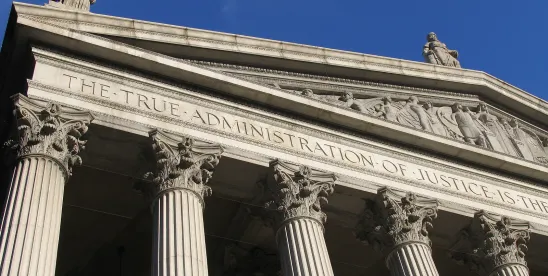On April 12, 2024, the Supreme Court of the United States unanimously held in Macquarie Infrastructure Corp. v. Moab Partners, L.P. that pure omissions are not actionable under Rule 10b-5(b), promulgated by the US Securities and Exchange Commission (SEC) pursuant to Section 10(b) of the Securities Exchange Act of 1934 (Exchange Act). The failure to make a material disclosure required by Item 303 of Regulation S-K cannot support a right of action under Rule 10b-5(b) when such failure does not render any “statements made” misleading.
Key Takeaways:
- Pure omissions are not actionable under Rule 10b-5(b). The omission of information from a public disclosure may only serve as the basis for Rule 10b-5(b) liability if that omission renders an affirmative statement misleading.
- This case may not change market practice with respect to disclosure drafting because public companies remain obligated to disclose known trends or uncertainties as required by Item 303 of Regulation S-K and could face liability for omissions under other statutory provisions.
IN DEPTH
CASE BACKGROUND
Section 10(b) of the Exchange Act makes it unlawful for any person to “use or employ, in connection with the purchase or sale of any security . . . any manipulative or deceptive device or contrivance in contravention of such rules and regulations as the [SEC] may prescribe.” Rule 10b-5(b) implements Section 10(b), making it unlawful for a person to “make any untrue statement of a material fact or to omit to state a material fact necessary in order to make the statements made, in the light of the circumstances under which they were made, not misleading.” Separately, Item 303 of Regulation S-K requires public companies to disclose in periodic filings with the SEC any “known trends or uncertainties that have had or that are reasonably likely to have a material favorable or unfavorable impact on net sales or revenues or income from continuing operations.” Item 303 is required in an issuer’s quarterly (10-Q) and annual (10-K) reports as part of Management’s Discussion and Analysis of Financial Condition and Results of Operations.
As alleged in the underlying complaint, Macquarie Infrastructure Corporation owned infrastructure-related businesses, including terminals that stored high-sulfur fuel oil. In 2016, the United Nations International Maritime Organization adopted a regulation severely limiting the use of that same high-sulfur fuel oil by early 2020 (IMO 2020). Macquarie did not discuss IMO 2020 in its public disclosures or in its filings with the SEC. In 2018, Macquarie announced that business for its fuel storage terminals dropped, due in part to IMO 2020. Macquarie’s share price declined by approximately 41% following the announcement. Investors brought a securities class action, alleging that Macquarie’s failure to disclose the anticipated effect of the IMO 2020 ban on its fuel storage business violated Item 303 of Regulation S-K and that Macquarie’s alleged omission triggered liability under Rule 10b-5(b). The US Court of Appeals for the Second Circuit, under its precedent, decided in the investors’ favor.
THE SUPREME COURT’S DECISION
The Supreme Court rejected the investors’ claim and vacated the Second Circuit’s decision, reasoning that the text of Rule 10b-5(b) only prohibits omitting a material fact necessary “to make the statements made . . . not misleading.” The Court emphasized that the focus of Section 10(b) and Rule 10b-5 is fraud, not disclosure: “Section 10(b) is . . . a catchall provision, but what it catches must be fraud.”
Other disclosure requirements generally support claims based on pure omissions. Section 11(a) of the Securities Act of 1933 proscribes any registration statement that “omit[s] to state a material fact required to be stated therein.” The Court reasoned that the absence of such language in Rule 10b-5(b) made clear that it was written only to prohibit (i) affirmative false statements and (ii) misleading half-truths, defined as “representations that state the truth only so far as it goes, while omitting critical qualifying information.” Under Macquarie, to succeed in claiming that an omission violates Rule 10b-5(b), a plaintiff must identify an affirmative statement that was rendered misleading as a result of the omission.
McDERMOTT INSIGHT
In some ways, the Court’s holding may not change much for public companies. Even if disclosure of certain information may not be required to escape liability under Rule 10b-5(b), public companies are still required to comply with Item 303 of Regulation S-K’s requirements to disclose known trends and uncertainties. The decision also does not impact the SEC’s ability to bring actions based on reporting and other violations, and individual plaintiffs may still pursue claims under Section 11(a). A market trend has yet to emerge indicating whether and how public companies may adjust disclosures in response to the Court’s decision, but issuers who previously included additional disclosures of arguably immaterial detail to err on the side of caution could rethink that balance as affirmative statements of any kind – material or not – could provide a foothold for plaintiffs and the SEC.
Macquarie could have serious ramifications for fraud claims brought by securities plaintiffs and the SEC. In our view, the Court’s holding will likely push plaintiffs one of two directions: they will either (i) look for textual hooks, such as generic compliance statements and risk factors that are rendered misleading by omission of a known trend or uncertainty or (ii) attempt to pursue traditional misstatement claims under scheme liability theory. The first path presents difficulties for private plaintiffs, who must wrestle with recent jurisprudence questioning whether a specific negative development renders a prior generic statement materially misleading. Plaintiffs will also face challenges when those textual hooks are forward-looking or opinions. As to the second path, both plaintiffs and the SEC could run headlong into caselaw that preserves the distinctions between misstatement liability under Rule 10b-5(b) and scheme liability under Rules 10b-5(a) and (c). Notwithstanding the Supreme Court’s decision in Lorenzo v. SEC, which permitted scheme liability claims based on the knowing dissemination of false statements, many courts continue to require conduct beyond an alleged misstatement or misleading omission to support fraud claims under Rules 10b-5(a) and (c).






 />i
/>i

